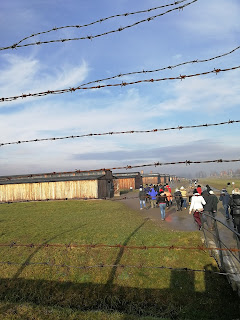 |
| The restored 'Arbeit Macht Frei' (Work Sets You Free) sign at Auschwitz-I |
Consequently, since 2001, Britain - and the wider international community - has marked 27 January as Holocaust Memorial Day.
Each year, the commemoration has a common theme - and, this year, that theme is the Power of Words.
So here then are a few words from me about Auschwitz-Birkenau following my visit there earlier this month:
THE WEIGHT of history hung heavily in the chilly winter fog which enveloped Auschwitz-Birkenau. Meanwhile, the dense, grey cloud and a biting wind contributed to an eerie atmosphere which was aptly oppressive and inescapable. It felt as if this was a place on earth which never sees the sun rise or the birds sing.
On arrival at Auschwitz, I boarded a bus for a short 10-minute ride from the main camp to Birkenau, also known as Auschwitz-II. There, I was confronted straightaway by its iconic Gatehouse which towered over the surroundings. It was not the Gatehouse, though, which was the most chilling element of Birkenau - but, instead, the sheer expanse of the camp beyond it.
The size of the preserved site, which measures 171 hectares, meant I did not have the time to walk to the end of the rail tracks. Nor did I have time to walk the whole length of the road along which victims, who were deemed unfit for manual labour, were immediately herded to the gas chambers and their deaths.
Birkenau, indeed, was where the vast majority of the victims of Auschwitz concentration camps died having been transported there on cattle trucks. But, when the Nazis heard the Soviets were closing in, they blew up nearly all of the buildings and left a vast, desolate landscape interrupted only by chimney stacks.
At Auschwitz, by contrast, the original exterior of the blocks remain standing and many of them now host museum exhibits dedicated to the victims. But, not all of them host exhibits.
Block 11 - the so-called 'death' block - has been fully reconstructed to show the various punishments which were applied to prisoners. Some of the prisoners were locked in a dark chamber for several days or were forced to stand in one of the four standing cells. Punishment in these special compartments consisted of confining four prisoners, who were forced by the lack of space to remain standing all night for up to 20 nights while still being forced to work during the day. Many died of exhaustion.
It was also in the basement of Block 11 - in cell 27 - that the first attempts to kill people with Zyklon B gas were carried out on 3-5 September 1941. In the test, 600 Soviet prisoners of war and 250 Polish patients selected from the camp hospital were murdered.
Thousands more prisoners - mainly Polish political prisoners - were lined up and shot at the now-reconstructed Death Wall in the courtyard between Blocks 10 and 11 between 1941 and 1943. There is now a candle-lit memorial at the site.
Not far from the Death Wall is a gas chamber which itself was reconstructed in 1947 by the Red Army as the Nazis had converted it into an air-raid shelter in 1944. The entrance door is completely original and the internal layout still shows there was a room for disrobing, another room in which the victims were gassed, and - adjacent to that - an oven room in which their bodies were burned.
Leaving the gas chamber was a deeply uncomfortable experience. Unlike myself, the Jews and other prisoners had not been granted the privilege of leaving that building alive, and my heart and my soul grieved for the thousands who had been consigned to their death there.
Indeed, it is impossible to leave Auschwitz completely unaffected by what you see. In an unfortunate way, the visit - at least briefly - left me disproportionately cynical about the human race as a whole. It never seems to learn.
Even today, there are plentiful unjust deaths happening all over the world in all sorts of horrendous conditions. And, while humankind has made great strides in many aspects of its existence, people still hate - and kill - other people simply because of their beliefs.
At an extreme level, that - of course - can result in genocide - and, since the Holocaust, there have been recognised genocides in Cambodia (1975-1979), Rwanda (1994), Bosnia (1995), and Darfur (2003-present).
All of the above are commemorated by Holocaust Memorial Day - but, frankly, even a single unjust death is one too many. Will we ever learn just to get along?
AUSCHWITZ
 |
| Exterior of the reconstructed gas chamber at Auschwitz |
 |
| Ovens inside the gas chamber at Auschwitz |
 |
| Reconstructed Death Wall in the courtyard between Blocks 10 and 11 |
 |
| Barbed wire surrounds the roads at Auschwitz |
 |
| A sign warned of the double electric fence which surrounded the enclosure |
BIRKENAU (AUSCHWITZ-II)
 |
| The Gatehouse at Birkenau |
 |
| Cattle car that brought prisoners to their deaths in Birkenau A single red rose now adorns the latch on the door |
 |
| The cattle car (left) and a watchtower (right) surrounded by the desolate landscape |
 |
| The death road along which victims were herded to the gas chambers |
 |
| The site at Birkenau measures 171 hectares |
Auschwitz was really a factory for killing, and human beings were used as fuel. I survived and promised myself, I will tell the world what happened
Lily Ebert Holocaust survivor
No comments:
Post a Comment